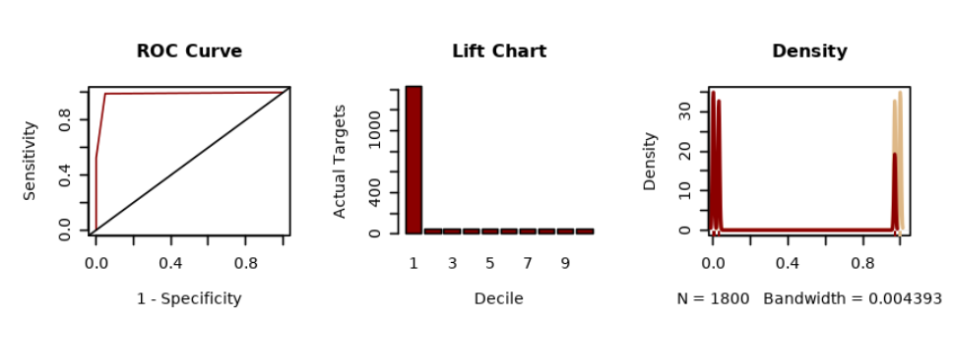3.1.4 評価
新しいデータでモデルを使用して予測を行う前に、まずモデルの精度を評価する必要があります。 様々なメソッドを使用してモデルを評価できます。
モデル精度の表示
モデルの精度を確認するために、混同行列を使用します。 混同行列は、各クラスの正しいモデル予測と誤った予測を示す表です。 混同行列を作成した後、正しい予測の数を予測の合計数で除算して、モデルの精度を計算します。
CMATRIX <- with(RES, table(AFFINITY_CARD, PREDICTION))
CMATRIX
PREDICTION
AFFINITY_CARD 0 1
0 1206 145
1 180 269モデルの精度を表示するには、次の文を実行します:
ACCURACY <- CMATRIX / sum(CMATRIX)
round(sum(diag(ACCURACY)),3)*100
83.6混同行列の結果は、テスト・セットの精度が83.6%であることを示しています
予測結果の表示
ここでは、予測結果を表示します。
- 予測結果を表示するには、次のコードを実行します:
z.show(ore.sort(RES[(RES$"'1'" > 0.5),], by = c("'1'")))
- ROC曲線、リフト・チャートおよび分布チャートを使用して予測結果を表示するには、次のコードを実行します:
# BAR PLOT res <- ore.pull(RES) sensitivity <- res[order(res$"'1'",decreasing = TRUE), ] sens <- sum(sensitivity$"'0'")/sum(sensitivity$"'0'") - cumsum(sensitivity$"'0'")/sum(sensitivity$"'0'") spec <- cumsum(sensitivity$"'1'")/sum(sensitivity$"'1'") # LIFT CHART decile2 <- quantile(sensitivity$"'1'", probs = seq(.1, .9, by = .1)) df_sens <- as.data.frame(sensitivity$"'1'", col.names = c("sens")) df_sens$decile = as.numeric(cut(1-cumsum(df_sens$sens), breaks=10)) # DISTRIBUTION CHART dx <- density(res$"'0'") dx2 <- density(res$"'1'") # PLOTS 3x1 par(mfrow=c(3,3)) plot(1 - spec, sens, type = "l", col = "darkred", ylab = "Sensitivity", xlab = "1 - Specificity", main = 'ROC Curve') abline(c(0,0),c(1,1)) paste("AUC: ", round(sum(spec*diff(c(0, 1 - sens))),3)) barplot(table(df_sens$decile), xlab = 'Decile', ylab = 'Actual Targets', main = 'Lift Chart', col = "darkred") plot(dx, lwd = 2, col = "burlywood", main = "Density") lines(dx2, lwd = 2, col = "darkred") # Add the data-poins with noise in the X-axis rug(jitter(res$"'0'"),col='burlywood') rug(jitter(res$"'1'"),col='darkred')
親トピック: 分類ユース・ケース